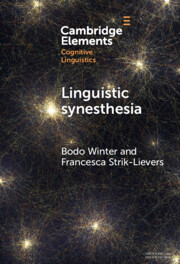Refine search
Actions for selected content:
275 results
15 - Semantics and Pragmatics
-
- Book:
- Inventing Languages
- Published online:
- 27 November 2025
- Print publication:
- 04 December 2025, pp 280-300
-
- Chapter
- Export citation
The Weight of Sedimentation: From Husserl to Foucault
-
- Journal:
- Dialogue: Canadian Philosophical Review / Revue canadienne de philosophie , First View
- Published online by Cambridge University Press:
- 24 November 2025, pp. 1-29
-
- Article
- Export citation
12 - Wordplay
-
- Book:
- The Prompts You Need to Help You Write the Book You Want to Write
- Published online:
- 25 October 2025
- Print publication:
- 06 November 2025, pp 167-184
-
- Chapter
- Export citation
1 - Introduction: The Personal Is Political – How I Came to Write This Book
-
- Book:
- Tied Up in Tehran
- Published online:
- 28 September 2025
- Print publication:
- 16 October 2025, pp 1-23
-
- Chapter
-
- You have access
- HTML
- Export citation
30 - Grammaticalisation
- from Part IV - Modelling the Record: Methods and Theories
-
-
- Book:
- The New Cambridge History of the English Language
- Published online:
- 18 October 2025
- Print publication:
- 16 October 2025, pp 744-767
-
- Chapter
- Export citation
Chapter 12 - Like Entering a Bright Room?
- from Part II - Historical and Philosophical Implications
-
-
- Book:
- Kant on Language
- Published online:
- 19 September 2025
- Print publication:
- 09 October 2025, pp 217-233
-
- Chapter
- Export citation
Chapter 7 - Kant’s Metaphors and Analogies
- from Part I - Linguistic Implications of Kant’s Thought
-
-
- Book:
- Kant on Language
- Published online:
- 19 September 2025
- Print publication:
- 09 October 2025, pp 120-136
-
- Chapter
- Export citation
The abstract concept of perceived power is embodied to a lesser extent in the second language
-
- Journal:
- Bilingualism: Language and Cognition , First View
- Published online by Cambridge University Press:
- 23 September 2025, pp. 1-11
-
- Article
-
- You have access
- Open access
- HTML
- Export citation
Chapter 13 - Ockham on Figurative Discourse
-
-
- Book:
- Ockham’s <i>Summa Logicae</i>
- Published online:
- 04 September 2025
- Print publication:
- 18 September 2025, pp 269-288
-
- Chapter
- Export citation

Applying Corpus Linguistics to Illness and Healthcare
-
- Published online:
- 05 September 2025
- Print publication:
- 25 September 2025
-
- Book
-
- You have access
- Open access
- Export citation
Chapter 3 - The Metaphors We Read With
-
- Book:
- How the World Became a Book in Shakespeare's England
- Published online:
- 09 August 2025
- Print publication:
- 14 August 2025, pp 73-119
-
- Chapter
- Export citation

How the World Became a Book in Shakespeare's England
-
- Published online:
- 09 August 2025
- Print publication:
- 14 August 2025
6 - The Metaphors We Partner By
- from Part I - The History and Conceptual Foundations of School–University Partnerships
-
-
- Book:
- The Cambridge Handbook of School–University Partnerships
- Published online:
- 05 November 2025
- Print publication:
- 07 August 2025, pp 107-127
-
- Chapter
- Export citation
Lifeboats and their problems: On the downsides of an influential metaphor in political theory
-
- Journal:
- Global Constitutionalism , First View
- Published online by Cambridge University Press:
- 25 July 2025, pp. 1-7
-
- Article
-
- You have access
- Open access
- HTML
- Export citation
Figurative language is (implicitly) more dynamic and emotionally deeper than literal language
-
- Journal:
- Language and Cognition / Volume 17 / 2025
- Published online by Cambridge University Press:
- 17 July 2025, e56
-
- Article
-
- You have access
- Open access
- HTML
- Export citation

Linguistic Synesthesia
- A Meta-analysis
-
- Published online:
- 11 June 2025
- Print publication:
- 03 July 2025
-
- Element
- Export citation
Chapter 39 - Lyric Trouble
- from Part IV - Afterlives
-
-
- Book:
- Percy Shelley in Context
- Published online:
- 17 April 2025
- Print publication:
- 24 April 2025, pp 300-308
-
- Chapter
- Export citation
Introduction
-
- Book:
- Henry James and the Writing of Transport
- Published online:
- 20 March 2025
- Print publication:
- 03 April 2025, pp 1-27
-
- Chapter
- Export citation
Numbers skyrocket in English but increase in Spanish: metaphoric conceptualization and manner expression in translations
-
- Journal:
- Language and Cognition / Volume 17 / 2025
- Published online by Cambridge University Press:
- 20 March 2025, e41
-
- Article
-
- You have access
- Open access
- HTML
- Export citation
